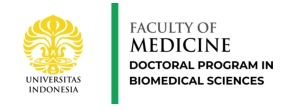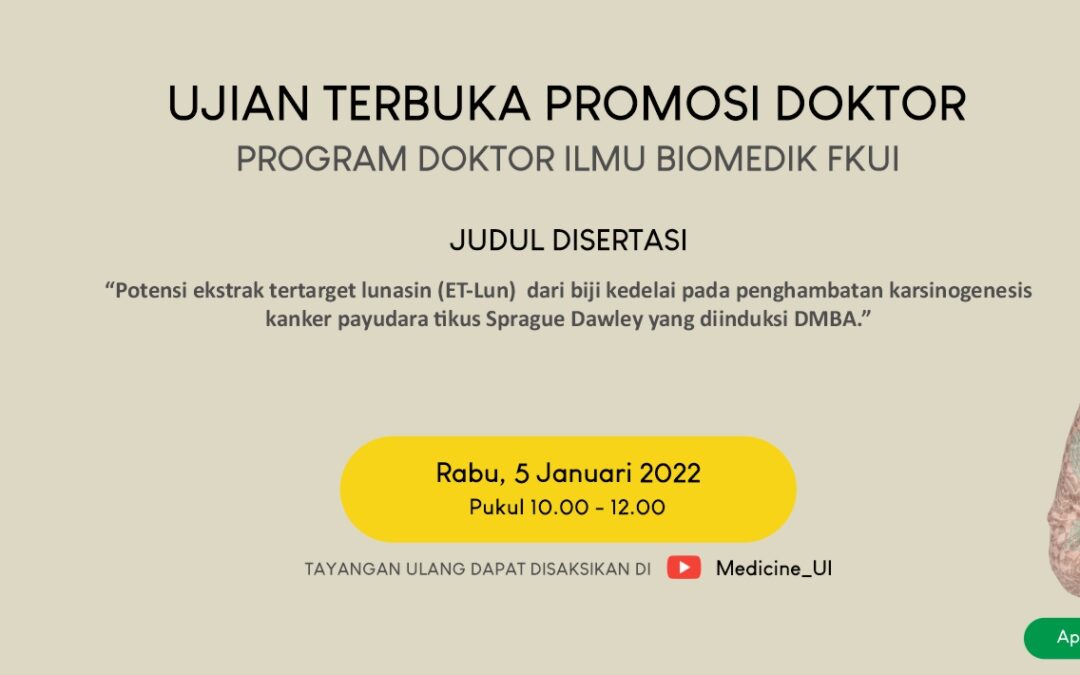POTENTIAL OF LUNASIN (ET-Lun) TARGET EXTRACTS FROM SOYBEAN SEEDS IN INHIBITION OF DMBA-INDUCED SPRAGUE-DAWLEY RAT BREAST CANCER
By: Apt. Numlil Khaira Rusdi, S. Farm, M. Si
Breast cancer (KPD) is the most common malignancy in women worldwide. In 2020 PROM is cancer with the highest incidence in the world and also in Indonesia.
Currently, many studies have been carried out to find cancer drugs with natural ingredients, including paclitaxel derived from the Taxus brevifolia plant which is used as an anticancer drug. Soybean (Glycine max (L.) Merr.) is one of the plants whose activity is being developed as an anticancer drug. Consumption of soy products is known to reduce the incidence and mortality of breast cancer, prostate cancer, colon cancer, and lung cancer. Recent studies have proven that a significant component as an anticancer from soybeans is a protein with the name “Lunasin”.
The problem is, the price of commercial lunasin is very expensive due to the high cost of synthesizing lunasin and takes a long time, the lack of methods to obtain pure lunasin from plant sources and the analysis of different cultivars shows that the content of lunasin varies significantly. To overcome this, in this study, a targeted extract of Lunasin (ET-Lun) from soybean seeds will be developed. This study explored the use of native Indonesian soybeans, the “Grobogan” variety, which was obtained from the Research Institute for Legumes and Tubers (Balitkabi) Malang.
The active compound in the ET-Lun preparation is Lunasin with a concentration of 0.09%. In addition to the Lunasin compound, the ET-Lun preparation also contains the active compounds of the isoflavones genistein, glycitein, and daidzein (HPLC and LCMSMS examination).
In this study, an in silico test was conducted to determine the affinity of binding of the active compound from soybean to the active site of the receptor target. The active compounds genistein, daidzein, coumestrol, carotene, phytoalexin, and lunasin, were seen for their binding to ERα, ERβ, HER2, and EGFR proteins, which are molecular markers for prognostic and specific predictive of PROM. The results of the Insilico test showed that Lunasin and genistein had the best binding to ERα, ERβ, and EGFR, while in HER2, the best bond was found in the compound daidzein.
Then the research continued to test the activity of ET-Lun in a rat model of breast cancer induced by DMBA. This research is divided into 2 major groups, namely curative and preventive groups. In the curative group, SD rats were induced with DMBA 20 mg/kg BW 11 times, 2 times a week, except normal control (NOR), then divided into negative control (DMBA), tamoxifen positive control (TAM), ET-Lun group 500mg/kg BW (ET-Lun), and a combination of ET-Lun and tamoxifen (ADJ). After forming nodules with a volume of 1-2 cm3, rats were given treatment according to their respective groups for 8 weeks, while in the preventive group (PREV), ET-Lun 500 mg/kg BW was given 1 week before induction, during induction, and after induction. DMBA with 24 weeks of treatment. After treatment, the mice were terminated, and the tumors were taken. Tumor volume was measured, and ERα, ERβ, HER2, and EGFR expression were examined by immunohistochemistry and qPCR.
The results of the study in the curative group; ET-Lun group, tamoxifen, and ET-Lun tamoxifen combination, can slow tumor growth during treatment. The tumor volume continued to increase but the increase in tumor volume was not as large as the DMBA control group. Molecularly, the ET-Lun group, tamoxifen, and the ET-Lun tamoxifen combination (adjuvant group) could significantly reduce ERα expression. In addition, the ET-Lun and adjuvant groups can also decrease EGFR expression. However, this decrease in molecular expression did not change the behavior of mice in the formation of PROM. To understand the curative activity of ET-lun, further research is needed on the PROM signaling pathways that may be inhibited by ET-Lun and the activity of the immune system that may be affected so that it can be indicated as a PROM drug.
What is interesting from this study is the ability of the preventive group to reduce the incidence of PROM tumors by 80% when compared to DMBA controls. In addition, ERα and EGFR protein and mRNA expression were significantly decreased in the preventive group. The results of this study indicate that the preventive group can inhibit the initial phase of KPD.l. The results of this study may be relevant for the prevention of PROM in women who have high-risk factors for PROM.
Promoter Team; Dr. Drs. Kusmardi, M.S; Prof. Dr. dr. Erni Hernawati Purwaningsih, M.S; Prof. Dr. dr. Andon Hestiantoro, Sp.OG(K), MPH
Test Team; Dr. dr. Sonar Soni Panigoro, MARS, M. Epid., Sp.B(K)Onk.; Prof. Dr. apt. Berna Elya, M.Si; Ahmad Rusdan Handoyo Utomo, Ph.D.; Prof. Dr. Abdul Salam M. Sofro, Ph.D.
Press release approved by Promoter Team

